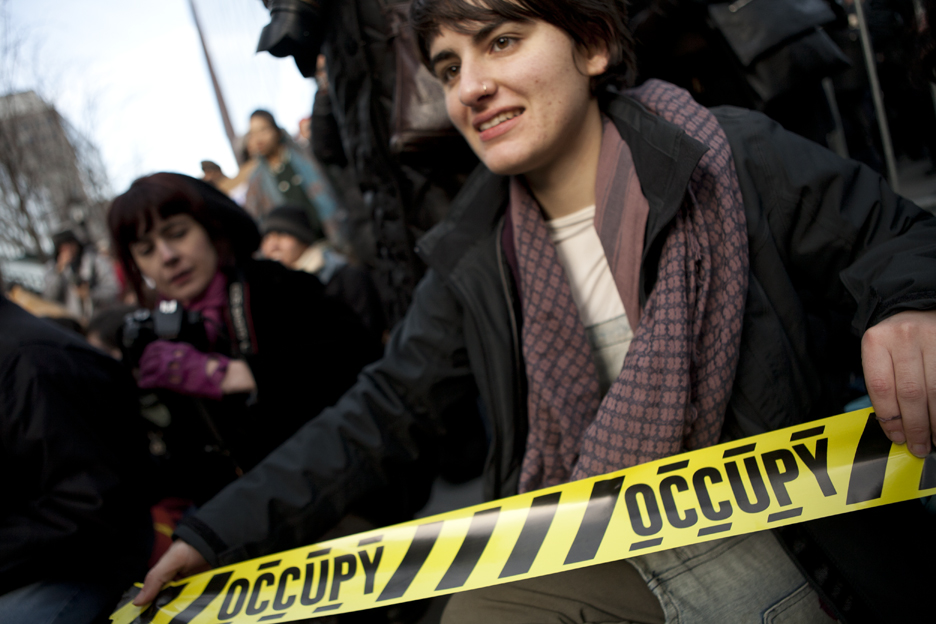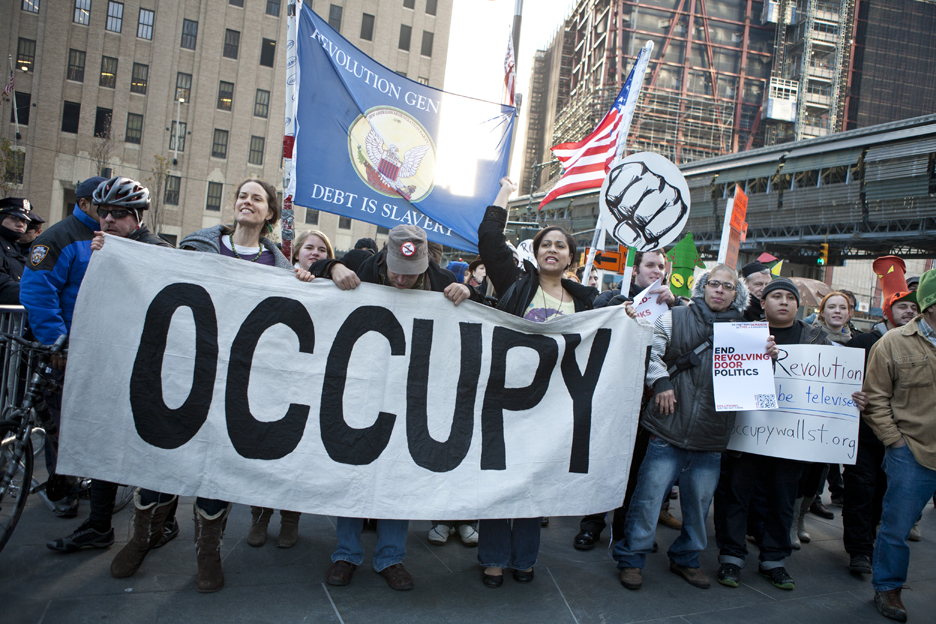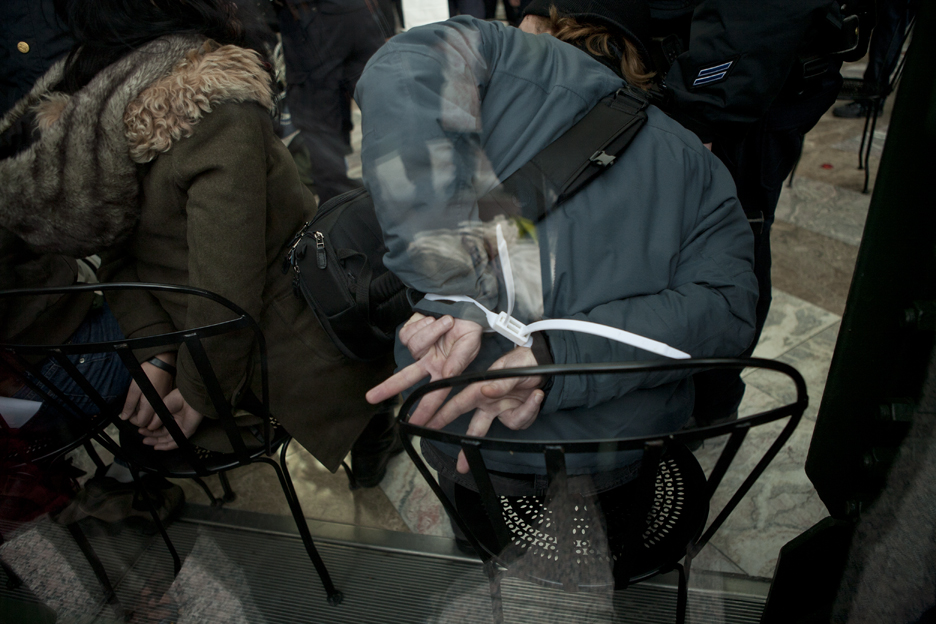The Montpelier/Minelab Experiment: An Archaeological Metal Detector Training Course
In March 2012, 12 metal detectorists were invited to James Madison’s Montpelier to attend a…
 Occupy and its offspring have brought issues that are of intrinsic interest to our discipline into the public consciousness in profound ways. I suggest that historical archaeologists have much to learn through a careful study of how Occupy has framed these issues, and much we could do to further advance them in the public mind.
Occupy and its offspring have brought issues that are of intrinsic interest to our discipline into the public consciousness in profound ways. I suggest that historical archaeologists have much to learn through a careful study of how Occupy has framed these issues, and much we could do to further advance them in the public mind.
Occupy began with a series of meetings between small working groups and veteran political organizers in late summer 2011, culminating in a planned march and gathering in New York’s Zuccotti Park on September 17. After a series of increasingly public actions drew (generally negative) media attention, the movement spread organically to other large (and eventually, small) cities across the United States. By late October, groups that took the Occupy label had spread around the globe–the German “Blockupy,” for instance. Following both evictions and intentional withdrawal from public spaces in most cities during the winter, small actions resumed in Spring 2012, but more significantly, a number of issue-oriented movements in the spirit of Occupy have replaced long-term, place-based encampments. These include such diverse things as “Occupy the Police,” “Occupy Anthropology,” “Occupy Sandy” (a reference to the hurricane that struck the Northeastern U.S. in October 2012), and the “Rolling Jubilee” anti-debt movement. (For brief histories of Occupy, see the Al Jazeera English-produced Fault Lines documentary History of an Occupation, and A History of Occupy (Earle 2012), from which I have drawn most of the above summary.)
 Occupy has always been a big-tent movement, both in terms of its membership and of the issues its activists raise (Earle 2012). This is a hallmark of consensus-based groups. Two themes stand out to me as fundamental to most of those who continue to organize under the Occupy banner: A focus on community formation and reproduction, especially in the interstices of the state; and an accessible, critical analysis of the social implications of global capitalism. In other words, “How do we validate intentional, interest-based social ties between people?” and “How do we demonstrate the ill effects of profit and exploitative labor on the daily lives of people in our communities?” Community-formation and reproduction, and the effects of capitalism, are significant parts of the research agendas of many of us working in this field (Matthews 2010), and Occupy has helped prime the public to be receptive to capitalism-centered theory and praxis (McGuire 2008) in ways that we have rarely seen.
Occupy has always been a big-tent movement, both in terms of its membership and of the issues its activists raise (Earle 2012). This is a hallmark of consensus-based groups. Two themes stand out to me as fundamental to most of those who continue to organize under the Occupy banner: A focus on community formation and reproduction, especially in the interstices of the state; and an accessible, critical analysis of the social implications of global capitalism. In other words, “How do we validate intentional, interest-based social ties between people?” and “How do we demonstrate the ill effects of profit and exploitative labor on the daily lives of people in our communities?” Community-formation and reproduction, and the effects of capitalism, are significant parts of the research agendas of many of us working in this field (Matthews 2010), and Occupy has helped prime the public to be receptive to capitalism-centered theory and praxis (McGuire 2008) in ways that we have rarely seen.
The interests of Occupy and historical archaeology align in ways that go beyond our shared intellectual concern with daily lives and global forces. We are part of what Occupy has constructed as “the 99 percent,” whether we work in academic settings that are increasingly under neoliberal assault (Agger 2004), in the public sector that is being squeezed under the weight of flawed austerity policies, or in cultural resource management with its rigid profit motive and accompanying class structure (McGuire 2008). Occupy’s concerns are our concerns, writ both large and small, in the communities in which we live and work.
 Moreover, both Occupy and historical archaeology attempt to make manifest (sensu González-Ruibal 2008) that which is hidden. For the former, it is how such things as the machinations of global political economy impact communities struggling with, say, disaster recovery. For us, making manifest is our stock in trade, encompassing everything from excavation and documentary research to publications and talks aimed at, as the saying goes, “giving voice to the voiceless.” Occupy and its offspring challenge us to go beyond simply revealing what is hidden, to the realm of praxis. Occupy Sandy, for instance, continues to organize help and build community through mutual aid work in New York and New Jersey neighborhoods where state and federal aid have not met the need. As of this writing, the Rolling Jubilee has bought and forgiven over $11 million in medical debt. Both of these examples demonstrate action that arose after careful study of a specific social problem, one that has its genesis in largely hidden forces but directly impacts real lives in real communities. That action in turn works to critique the system that nurtures and sustains the problem itself.
Moreover, both Occupy and historical archaeology attempt to make manifest (sensu González-Ruibal 2008) that which is hidden. For the former, it is how such things as the machinations of global political economy impact communities struggling with, say, disaster recovery. For us, making manifest is our stock in trade, encompassing everything from excavation and documentary research to publications and talks aimed at, as the saying goes, “giving voice to the voiceless.” Occupy and its offspring challenge us to go beyond simply revealing what is hidden, to the realm of praxis. Occupy Sandy, for instance, continues to organize help and build community through mutual aid work in New York and New Jersey neighborhoods where state and federal aid have not met the need. As of this writing, the Rolling Jubilee has bought and forgiven over $11 million in medical debt. Both of these examples demonstrate action that arose after careful study of a specific social problem, one that has its genesis in largely hidden forces but directly impacts real lives in real communities. That action in turn works to critique the system that nurtures and sustains the problem itself.
In short, Occupy demonstrates praxis–a dialectic of analysis, critique, and action. Our field excels at summoning new knowledge from its hiding places, but knowledge and critique without action is of questionable utility. An Occupy-inspired historical archaeology would rest on all three legs of praxis. So what might some examples look like in practice?
In short, it would be an archaeology that seeks out the hidden lives disrupted by capitalism, by non-local politics, by market relations (Matthews 2010: 14), by government policies that prioritize austerity over people’s well-being (Buchli and Lucas 2001).
 These disrupted lives are all around us, in our own communities. They’re being lived by perhaps thousands of homeless in the storm sewers beneath Las Vegas, as well as in a network of self-dug (and quickly demolished by police) tunnels in Kansas City. They’re being lived by people being sent to jail for unpaid debts. They’re being lived by people forced into tent cities in some of the wealthiest regions of the United States.
These disrupted lives are all around us, in our own communities. They’re being lived by perhaps thousands of homeless in the storm sewers beneath Las Vegas, as well as in a network of self-dug (and quickly demolished by police) tunnels in Kansas City. They’re being lived by people being sent to jail for unpaid debts. They’re being lived by people forced into tent cities in some of the wealthiest regions of the United States.
This would be an archaeology that is multidisciplinary, multi-sited, and politically engaged. It would be one that begins in the present but does not necessarily end there.
There are examples. These themes run through much work on the so-called “contemporary past.” They hum throughout Jason De León’s work on the Undocumented Migrant Project. And they are brought out vividly in the work of Rachael Kiddey and her team on homelessness in Bristol, which enlists the homeless in a reflexive archaeology aimed at understanding the material and social causes and experiences of living on the streets (Kiddey and Schofield 2011).
None of the above, to my knowledge, position themselves as aligned with Occupy–nor do I suggest that they, or anyone else, must. But they’re generating knowledge and critique and action that fall directly in line with the key themes that Occupy and its offspring are raising. A sense of nearness and solidarity with the people being studied is key (“we are the 99 percent”). Action that flows from praxis must be collective action involving the people who live under the weight of the social problem in question, otherwise it could be co-opted to reinforce alienation.
I suggest that our field has the ability to bring unique knowledge, analysis, and methods to bear on revealing present-day lives and experiences of people pushed to the margins. This would be useful knowledge and critique to activists who cross-cut social lines, united by class interests, and experienced in organizing community-based aid and consciousness-raising. Occupy is pointing us toward an object, and it welcomes new sources of willing bodies and minds. Are we willing to listen, study, and act?
Buchli, Victor, and Gavin Lucas
2001 The Archaeology of Alienation: A Late Twentieth-Century British Council House. In Archaeologies of the Contemporary Past, Victor Buchli and Gavin Lucas, editors, pp. 158-168. Routledge, London.
Earle, Ethan
2012 A Brief History of Occupy Wall Street. Rosa Luxemburg Stiftung, New York.
González-Ruibal, Alfredo
2008 Time To Destroy: An Archaeology of Supermodernity. Current Anthropology 49(2): 247-279.
Kiddey, Rachael, and John Schofield
2011 Embrace the Margins: Adventures in Archaeology and Homelessness. Public Archaeology 10(1): 4-22.
Matthews, Christopher N.
2010 The Archaeology of American Capitalism. University Press of Florida, Gainesville.
McGuire, Randall H.
2008 Archaeology as Political Action. University of California Press, Berkeley.
All Images are by Jessica Lehrman from the Occupy Wall Street Flickr Archive and are licensed under the Creative Commons Attribution-NonCommercial.
Hey John–Great post. I would also add that there is a distinct spatiality and materiality to protest that is little understood. Given how important control of space is in regimes of domination and resistance, we have very little data on how space is utilized and reconfigured by protesting groups in such instances. Studies of occupy camps (of which I believe there are a few) would add to this interesting data-set and provide for longer-term studies of the modern world and its discontents.